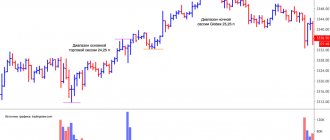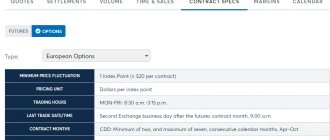A short introduction
Friends, greetings.
I have been trading only futures for the last two years and decided to write several articles about futures trading on the Moscow Exchange. I hope you find this information very useful. Moreover, futures often provide the opportunity to earn fabulous money. I had a case when in one dollar/ruble futures transaction I earned more than 90% of the profit.
By the way, there is a video about this on my YouTube channel.
Currently, many private investors are faced with the question of how to optimally allocate free funds, while being able to manage investment risks and count on a high level of profitability.
In the current difficult environment of increased uncertainty, for many individuals it is becoming a priority and in demand to make investments for short periods (from several months to a year) with the possibility of conducting speculative operations.
When we are talking about amounts of money exceeding the amount guaranteed for return by the state on bank deposits, the rate on which has been constantly decreasing recently.
And an additional tax is introduced on the interest income itself, or when savings investment products do not provide the desired level of profitability, working with futures may be a worthy option.
Futures vs. Stock
What is the difference between futures and stocks? Let's look at the most important differences:
- No dividends. There are payments for stocks, but there are none for futures.
- You can hold a stock as long as you want, futures until the expiration date. On this date, settlements between counterparties are made with each other.
- When we buy a share in a brokerage account, the amount must be 100% of the lot price. If you need to buy futures on a share, you don’t need the full amount, you need the amount of the guarantee, on the Moscow Exchange it’s 10-20%.
- When we buy a stock, we see the profit on it when we close the deal. In futures, profit is visible every day - this is variation margin, it is credited to the account and can be used for further transactions.
- Margin Call. When you bought a share, and even when the price of this share drops to zero, you can hold the share and wait for it to rise. If we work with futures, the situation is different. When there are fewer funds in the account, which constitute the collateral, the broker can close the margin call transaction. Thus, the investor loses money.
Futures contract and principles of its trading
One of the most popular instruments for short-term speculative investing is futures (from English: “futures” or “futures contract”). A futures is a derivative financial instrument (derivative) from the main, underlying asset.
The underlying asset can be any financial instrument: stocks, bonds, commodities listed on exchanges (oil, gold, metals, grain), as well as stock indices, currencies and currency pairs, indices, interest rates.
In essence, a futures contract is a binding contract between the parties (seller and buyer), a contract that after an agreed period of time (usually the contract always specifies a specific date), the buyer will buy back the underlying asset from the seller at a price that was agreed upon directly in moment of signing the contract.
Thus, the two key properties of futures are as follows:
- Any futures contract is based on the underlying asset, and the future itself is its derivative;
- Futures always have an expiration date.
These key properties explain the fact that futures trading on the Moscow Exchange (MB) takes place in a separate segment - the derivatives market (FORTS), which is one of the leading platforms that enjoys constant high interest among investors.
The Moscow Exchange is the flagship for organizing work with derivative financial instruments in Russia and Eastern European countries.
The increased interest of investors in the derivatives platform is associated with clear and uncomplicated conditions for starting trading for private investors, and the presence of a developed infrastructure on the exchange.
This infrastructure ensures information security of operations, guaranteed by the exchange itself, as well as the ability to use modern technologies that have been proven and have successful experience in practical application in exchange futures trading.
For trading futures on the Moscow Exchange, of which the most popular are contracts for stocks, commodities, currencies and currency pairs, indices (for example, the volatility of the Russian market. Today, about 50 underlying assets are available.
Trading volumes in the derivatives market, both in global and Russian practice, significantly exceed trading volumes in underlying assets.
Current prices of futures contracts for shares of Russian issuers on the Moscow Exchange (May 2021)
Preliminary market analysis
In order to select a futures contract for speculative trading or before concluding a particular transaction with the selected futures, it is necessary to conduct at least a cursory analysis of the current market situation. Currently, the most popular methods for studying the current and forecasting the future market situation are fundamental and technical market analysis.
Fundamental analysis of futures
This type of analysis is aimed at examining a variety of micro- and macroeconomic indicators that could potentially affect the future prices of futures contracts. Since the futures price has a strong correlation with the price of its underlying asset, all those factors that in one way or another can influence the balance of supply and demand in relation to the underlying asset are examined.
For example, if we are talking about currency futures, then the main factors that can influence them are such important indicators of the FOREX market as interest rate levels, inflation and deflation indicators in countries whose national currencies make up the currency pair under study. Various types of macroeconomic news published both on a regular basis (in the so-called economic calendar) and spontaneous news have a great influence.
If we talk about the stock market - futures for stocks and bonds, then the dominant role in conducting fundamental analysis is played by all the numerous microeconomic factors associated with the work and financial condition of the issuing company (mostly we are talking about data from regular financial statements). In addition, in this case, great influence is given to the analysis of fundamental ratios, such as: P/CF, EPS, P/B, P/S, PEG, P/E (read more about them in the section fundamental analysis ratios) .
Typically, fundamental analysis of the stock market is carried out from top to bottom: first, macroeconomic factors that influence the state of the economy as a whole are considered, then the situation in the industry to which the issuer of the underlying futures asset belongs is analyzed, and finally the condition of the company itself (the issuer of the underlying asset) is assessed.
You can get acquainted with the basics of fundamental analysis by clicking on the link: “Fundamental market analysis and methods for conducting it.”
Technical analysis of futures
This type of analysis is carried out exclusively using price charts. A technical analyst is not particularly interested in how the underlying fundamental indicators change, since in his work he is guided by the basic postulate of technical analysis:
The price on the chart already includes and reflects absolutely all those factors that can influence it in one way or another.
Another basic postulate of technical analysis is the statement that price tends to move in so-called trends. That is, in other words, at any current moment in time the price is in one trend or another (upward or downward) trend. And even if you see a clear absence of a trend on the chart (the price is in a flat), this only means that only a small section of the entire price chart is open to you and in fact the current flat is nothing more than a consolidation zone before the next reversal of the trend present on chart with a large time frame.
Trends visible on charts of small time frames are nothing more than components of trends on charts of large time frames. So a downward trend on a chart with a period of M5 (five minutes) may be just part of an uptrend on a chart with a period of H1 (hour), take a look at the figure below:
Patterns and support/resistance levels play a big role in technical market analysis. A pattern is a certain formation formed on the price chart, after the appearance of which there is a high probability of price movement in a certain direction. And support and resistance levels are price levels that the price is unable to overcome for quite a long time (the longer, the stronger the corresponding level). The support level is located below the price, and the resistance level is located above it. Read more about the analysis of levels and the basics of trading on them in the material: “Support levels and resistance levels.”
In addition, technical market analysis has a whole range of tools called indicators.
In general, a technical indicator is the quintessence or distillation of the entire price chart for a certain period of time.
Thanks to the use of modern computing power, it is possible, as they say, to examine the price chart from different angles and in different aspects. Indicators are built based on price chart data and are designed to simplify the process of analyzing the entire huge array of data of its components.
The result of the indicator is usually a buy signal (indicating that the price will rise) or a sell signal (indicating an impending price decrease). These kinds of signals coming from individual indicators are very unreliable, and therefore their use makes sense only in conjunction with other technical analysis tools (with other indicators, support/resistance lines, patterns).
You can read more about indicators here: “Technical analysis indicators”
Distinctive features of the derivatives market
The main focus of the derivatives market is to carry out speculative transactions in order to extract increased income.
To enter this market and start working, an investor, as a rule, does not need the full amount to pay for the contract; a guarantee is sufficient (about 10% of the contract price), while both possible profit and possible loss when working with derivative financial instruments are significant higher than with underlying assets: stocks, bonds or indices.
Distinctive features of the derivatives market are the ability to carry out risk insurance, lower commissions compared to the stock market and a longer trading day, which makes it possible to react more quickly to events even after the stock market closes.
On the Moscow Exchange, the trading session takes place from 10:00 to 23:50. From 14:00 to 14:05 and from 18:45 to 19:00 trading is suspended for the clearing session.
As a result of the clearing session, the results of past trading are summed up, after which the collateral is adjusted, depending on whether the price of the underlying asset for which the futures contract is issued has risen or fallen in price.
Another important point is property rights: by purchasing shares on the stock market, you become a co-owner of a share in the company whose shares you purchased, have the right to participate in the annual meeting of shareholders, and receive dividends.
When working with a stock derivative, you do not acquire property rights, but only fix the purchase or sale price of the stock after the period established by the contract.
During its operation, the Moscow Exchange introduced futures contracts into trading circulation, the underlying assets for which are:
- RTS indices
- Moscow Exchange
- Russian volatility index
- Indices of key industries (oil and gas complex, metal production and processing)
- Shares of Russian companies
- Federal bonds
- Currency and currency pairs
- MosPrime 3-month loan rate
- Commodities.
Currently, the Moscow Exchange is working on futures contracts for shares of 30 companies, Russian and German. Among them are Tatneft, VTB Bank, Magnit, Gazprom, Sberbank, Siemens, Volkswagen. All futures for shares of Russian companies are deliverable.
The commodity futures in demand among traders is for Brent oil. About 12 contracts are available for trading. In addition to oil, gold, silver, copper, platinum, palladium and sugar are available as underlying assets.
Futures for the RTS index, two futures for the Moscow Exchange index, and a contract for the Russian market volatility index (RVI) are available for trading.
The advantage of index contracts is that it gives you the opportunity to play the market as a whole, rather than individual shares. Futures on the RVI volatility index are a speculative instrument that allows you to bet on an increase or decrease in volatility
At the end of 2021, currency and commodity futures account for the most significant trading volume: about 40% for commodity futures and more than 30% for foreign exchange futures of the total volume of the MB derivatives market, respectively.
Moscow Exchange index chart (May 2021)
It is preferable for an investor who wants to start working in the derivatives market to be familiar with the principles of operation in the markets of underlying assets in order to easily navigate the terminology and work freely with the exchange software.
Also, in order to make a balanced and informed decision and start trading futures on the Moscow Exchange, you need to understand the specifics of investing in this financial instrument, understand the basic principles of maximizing profitability and managing risks on them.
Contract Specification
Each futures contract has a specification - this is a document that specifies the key parameters of this contract itself. It is determined by the exchange. And the price and duration of the futures are determined by the market itself. As a result, the trader can only choose a suitable contract and buy or sell it according to the proposed conditions.
So, what can be found in the specification:
- The full name of the futures and its ticker is a short name. It is by ticker that futures can be found in QUIK and other trading applications.
- Futures type . Let me remind you that futures are either delivery or settlement. With delivery, you will need to buy the product itself on the expiration date of the contract; with settlement, the exchange will simply recalculate the margin and you will receive your income (or loss).
- Size (lot). This is the number of units of the underlying asset that are included in one futures contract.
- Price step. This is the price in the trading currency at which the futures price changes. If the ruble futures have a step of 1, then the future changes in steps of 1 ruble.
- Execution date. When futures expire, they are actually redeemed: the parties fulfill their obligations, and the future itself is cancelled. Settlement contracts involve final settlement, while delivery contracts involve the purchase and sale of an asset. The last day of futures trading on the Moscow Exchange is the third Thursday of the month and year in which the futures contract is settled. But the actual execution of the futures takes place on the next trading day after the expiration date. Usually this is Friday, but if Friday is a holiday, then Monday (or Tuesday and beyond).
Here's another interesting article: How to invest in gold: 7 ways
For example, a futures contract on Gazprom shares with the ticker GAZR-3.20 has a closing date defined as March 19, 2021, and execution will take place on March 20, 2021.
By looking at the futures symbol, you can get basic information about the contract. The short name of the contract is determined according to the following scheme (using the example of the ticker GAZR-3.20):
- the first 2-3 letters of the Latin alphabet are a short designation of the underlying asset underlying the futures (GAZ);
- the next letter is the futures currency (R);
- the number after the dash is the month of contract execution (3);
- the numbers after the dot are the expiration year (20).
There is also a short code that uses futures codes that you will have to remember if you want to trade the derivatives market. The code for the same future looks like this: GZH0. Let's look at its structure:
- the first 2-3 letters are the designation of the underlying asset (GZ);
- the next letter is the month of futures execution (H);
- the number is the year in the current decade (0 is 2021, 1 is 2021, 2 is 2022, etc.).
It is better to remember the coding of the underlying asset and month. For example, MX is the Moscow Exchange index, RI is the RTS index, VI is volatility, AF is Aeroflot, GZ is Gazprom, RN is Rosneft, BW is BMW, BR is Brent oil, SA is raw sugar, GO is gold , NG – natural gas, etc.
The months are designated as follows:
| Month | Futures code |
| January | F |
| February | G |
| March | H |
| April | J |
| May | K |
| June | M |
| July | N |
| August | Q |
| September | U |
| October | V |
| November | X |
| December | Z |
A complete list of all futures codes can be found on the Moscow Exchange website at: https://www.moex.com/a214, but here is part of this table:
| Group of contracts | Underlying asset code (field “C”) | Code of the underlying asset on the derivatives market | Name of the underlying asset |
| Index contracts | MX | MIX | Moscow Exchange Index |
| MM | MXI | Moscow Exchange Index (mini) | |
| R.I. | RTS | RTS Index | |
| R.S. | RTSS | Blue Chip Index | |
| 4B | ALSI | FTSE/JSE Top40 Index | |
| VI | RVI | Volatility of the Russian market | |
| Stock contracts | A.F. | AFLT | PJSC Aeroflot (u.a.) |
| AL | ALRS | AK “ALROSA” (PJSC) (o.a.) | |
| CH | CHMF | PJSC Severstal (o.a.) | |
| FS | FEES | PJSC FGC UES (o.a.) | |
| GZ | GAZR | PJSC Gazprom (o.a.) | |
| G.M. | GMKR | PJSC MMC Norilsk Nickel (o.a.) | |
| HY | HYDR | PJSC RusHydro (o.a.) | |
| L.K. | LKOH | PJSC NK “LUKOIL” (o.a.) | |
| MN | MGNT | PJSC “Magnit” (o.a.) | |
| M.E. | MOEX | PJSC Moscow Exchange (o.a.) | |
| M.T. | MTSI | PJSC “MTS” (o.a.) | |
| N.M. | NLMK | PJSC NLMK (o.a.) | |
| N.K. | NOTK | PJSC NOVATEK (o.a.) | |
| RN | ROSN | PJSC NK Rosneft (o.a.) | |
| RT | RTKM | PJSC Rostelecom (o.a.) | |
| SP | SBPR | PJSC Sberbank (p.a.) | |
| S.R. | SBRF | PJSC Sberbank (o.a.) | |
| S.G. | SNGP | OJSC “Surgutneftegas” (p.a.) | |
| SN | SNGR | OJSC “Surgutneftegas” (o.a.) | |
| TT | TATN | PJSC Tatneft named after. V.D. Shashina (o.a.) | |
| TN | TRNF | PJSC Transneft (p.a.) | |
| VB | VTBR | VTB Bank (PJSC) (o.a.) | |
| MG | MAGN | PJSC “Magnitogorsk Iron and Steel Works” (o.a.) | |
| P.L. | PLZL | PJSC Polyus (o.a.) | |
| B.W. | GBMW | BMW AG (s.a.) | |
| DM | GDAI | Daimler AG (s.a.) | |
| D.B. | GDBK | Deutsche Bank AG (s.a.) | |
| S.M. | GSIE | Siemens AG (s.a.) | |
| V.M. | GVW3 | Volkswagen AG (p.a.) | |
| Commodity contracts | BR | BR | BRENT oil |
| C.U. | C.U. | copper | |
| G.D. | GOLD | gold | |
| P.D. | PLD | palladium | |
| P.T. | PLT | platinum | |
| SV | SILV | silver | |
| S.A. | SUGR | raw sugar | |
| SL | SLV | silver (delivery) | |
| A.M. | ALMN | aluminum | |
| C.L. | C.L. | Light Sweet Crude Oil | |
| Co | Co | Grade A copper | |
| GO | GLD | gold (delivery) | |
| Nl | Nl | nickel with a purity of 99.80% (minimum) | |
| Zn | Zn | zinc | |
| NG | NG | natural gas | |
For up-to-date data, it is better to contact the original source.
Features of futures trading on the Moscow Exchange
Leverage
The key difference (and, perhaps, one of the main advantages) of working with futures from working with any of the underlying assets is the fact that a private investor does not have to have the entire amount to purchase a futures at the time of concluding the contract.
The exchange, as a guarantor of the execution of the transaction, provides free leverage and requires the investor to deposit only part of the amount as a guarantee of the execution of the futures contract, and is called “guarantee collateral”.
Table from the Quik terminal with data on the GO of the futures I traded
Depending on what the underlying asset is the basis for the futures, the range of collateral varies on the Moscow Exchange from 8 to 13% of the main value of the contract.
Savings on commissions
Another major benefit of dealing with futures is lower fees compared to the stock market.
When dealing with shares, the key and most significant commission is the payment to the depository for electronic storage and accounting of securities. In the case of futures, there are no requirements for depository storage and accounting, and the commission is paid only to the exchange as a guarantor of the transaction and to the broker for intermediation and provision of trading services on the exchange.
Possibility of working with short selling
When working with futures contracts, there are no restrictions on short selling - the buyer has the opportunity to sell the underlying asset for which the contract is concluded without owning the asset itself.
Futures are derivative instruments, so their sale or purchase is determined only by the action, without the need to “borrow” from the broker the necessary underlying assets (for example, stocks or bonds) with the obligatory need for their mandatory subsequent return, most often with interest.
When organizing trading in derivative financial instruments on the Moscow Exchange, the values of the underlying asset (quantity, quality characteristics, packaging, application of special markings, if we are talking, for example, about commodities) are prescribed in the specifications for the main contract and are standardized parameters for the trading platform, since the exchange conducts their trading.
The key point is the obligation of both the seller and the buyer to execute the futures contract at the redemption period and price agreed upon in the contract. In this case, the MB acts as a guarantor of the transaction.
Types of futures contracts
Futures contracts can be delivered or settled.
In a deliverable futures contract, the buyer undertakes to buy from the seller the value (quantity) of the underlying asset pre-agreed in the specification directly at the price that, according to the approved methodology, is fixed on the date of the last trading.
An example of a deliverable futures contract using the example of futures on Sberbank shares
If the futures contract has expired and the seller is unable to deliver the underlying asset to the buyer, the Moscow Exchange, as the guarantor of the transaction, imposes a fine on the seller, compensating the buyer for his losses.
With a non-deliverable (settled) futures, monetary settlements between the seller and the buyer under the contract are carried out only for the difference in the amount between the futures price and the market price of the underlying asset at the time the contract is executed. There is no physical delivery of the underlying asset.
An example of a non-deliverable contract based on the example of futures on the RTS index
This is a convenient method of calculation when there are goals of hedging (insurance) risks from changes in the price of the underlying asset or in the case of speculative transactions.
Arbitrageurs in the FORTS market
In this version of trading on the FORTS derivatives section, there is arbitrage. If we describe this rather rarely used type of speculation, it will look like this: “Classic” arbitrage transactions are carried out on different markets. However, when using a financial instrument from the same issuer. But here you need to understand the following: This method of trading, such as arbitrage, implies not only a virtual absence of risk, but also the minimum possible profit.
Further, in order to at least to some extent clarify the methods of this method of manipulating FORTS instruments. I propose to briefly familiarize yourself with the terms that, to one degree or another, relate to derivative instruments. To the futures and options market of the Russian trading system. And to the arbitrage trading method as such:
Writing materials on trading in text is very difficult. It is much easier to do them in video format. This is what we have been doing for more than 6 years! Subscribe to us and get the cream of information!
YouTube channel
SPOT market
This is the very thing that is not a real market for financial instruments. This market differs from the FORTS derivatives section in that transactions here are concluded from an instant to 2 days. Another distinctive feature of this market is that assets are traded here for “cash” payments. Not in the understanding of cash payments as banknotes. And in the understanding that settlement of securities is supported by the right to property of shares of companies or obligations.
It is from this feature of the spot market that a completely logical conclusion follows. By the way, it is decisive for our context – arbitration! Namely, since this is the most “fair” market, this means that prices for financial assets here are the most current at the moment! In the context of the material we are considering, the spot market is the Moscow Stock Exchange.
How do you work with futures?
Trading in derivative financial instruments takes place in the derivatives section of the MB.
Let’s look at one of the options using a specific example in order to understand what principles are embedded in the trading mechanism on the derivatives market of the exchange.
Suppose you, as a private investor, see prospects in the development of one of the companies whose shares are traded on the stock exchange. In January 2020, you, as a buyer, decide to purchase 10 shares of this company at a price of 200 rubles per share until October 2021.
At the time of concluding a futures contract, you pay part of the amount, which acts as a guarantee of your desire to purchase shares. If by the time the futures contract is executed in October, the price of the shares meets your expectations and rises to 240 rubles, you will be able to buy them at the price fixed in January and immediately sell them on the exchange at the current market price.
In this case, your income from one share will be 40 rubles, and the income from the package of shares included in the futures contract will be 400 rubles.
The guarantee when working on the Moscow Exchange when concluding a futures contract on shares is about 10%, and this means that in order to conclude a contract worth 2,000 rubles, you, as an investor, need to provide only 200 rubles to the exchange, which acts as a guarantor of the transaction.
Definition and Historical Origin of the FORTS Market
In order to fully understand what is here and what they eat with, let’s start with a little background. Initially, there were 3 trading and financial platforms in Russia. Moscow Stock Exchange , located, of course, in the capital of Russia. securities as shares , bonds and other securities of the country's leading issuers were in circulation .
The stock exchange located in St. Petersburg also conducted trading with the same list of exchange instruments. And, in fact, there, in the second capital of Russia, there existed the Russian Trading System - RTS. But in 2001, the RTS merged with the St. Petersburg Stock Exchange. The purpose of the merger was to organize the FORTS derivatives market.
In general, “FORTS” is not the name of the market, as such, but an abbreviation that consists of derivatives . The name of these derivative instruments constitutes this abbreviation – “Futures and Options of the Russian Trading System”. The organizer of the trades was RTS itself, and non-cash payments were carried out by the Closed Joint Stock Company (CJSC), RTS Clearing Center.
Now it's 2011. Representatives of the Moscow and St. Petersburg stock exchanges decide to reunite the Moscow Stock Exchange with the FORTS market. Then the FORTS market moves from St. Petersburg to Moscow. After which this association is renamed into Open Joint-Stock Company (OJSC), “Moscow Stock Exchange MICEX-RTS”.
Decision is made. Where to begin?
For individuals who have decided to trade futures on the Moscow Exchange, they need to decide on a broker through whom they will gain access to the exchange terminal.
Next, you need to download a special application or program, add funds to your account, and you can start trading. At the moment, the process is organized in such a way that the buyer selects a futures contract that suits him in terms of settlement period and price, and makes a transaction with the seller.
Apart from the price and term of the futures contract, all other parameters are standardized by the exchange; in essence, the buyer selects the offer he is interested in and agrees with it.
The same is the case with the seller, whose submitted application indicates the number of shares, bonds, goods that he wants to sell, and the price. The transaction will take place if a buyer is found according to the specified conditions.
It's simple!
Important points when placing an order and working with futures contracts are the following points:
- At the time of concluding a futures contract and during its validity, the futures price is always lower than the price of the underlying asset;
- The closer the contract is executed, the more the futures price tends to the market price of the underlying asset, and is ultimately compared with it.
Contango and backwardation
Contango – Contango is of Latin origin meaning “price premium.” This concept of this thesis assumes that the price of the underlying asset is below the current price of the derivative representing that underlying asset. Or: For example, the current futures price is higher than the market value of its guide, the underlying asset - stocks, bonds...
Backwardation - Backwardation , also from Latin origin, means “delay.” And this term implies that the current price of the futures contract is lower than the current value of the underlying asset. Or: The price level of the underlying security is higher than the current price of its derivative instrument - futures. Schematically it will look like this:
So, to carry out an arbitrage transaction, the arbitrator finds a situation in the FORTS forwards section that meets the contango conditions. Here, when it is detected, the trader sells the deliverable type of futures contract. At the same time, he acquires the underlying asset corresponding to this futures. Now, at the time of expiration of this futures contract, the arbitrageur sells this underlying instrument to the counterparty. Thus, the difference between the purchase price and the sale price, say, of a security, becomes the arbitrageur’s profit.
Example: We sell Sberbank deliverable futures at a price of 20,050 rubles. And we buy shares, of the same Sberbank, at their cost of 200 rubles per share. When the expiration date is reached, we are obliged to supply the counterparty, that is, the buyer, with a share of 200 rubles. So, with the mutual closure of our forward and spot positions, the income will be 0.5 rubles from one Sberbank paper.
Expiration: what is important to remember
The date of execution of a futures contract is called expiration, and it is necessary to work with execution contracts on these days with the utmost correctness. On the Moscow Exchange, expiration is set unified for all derivatives, in accordance with the exchange calendar.
There are quarterly expirations occurring in March, June, September and December, with the last trading day being determined between the 15th and 20th of the expiration month.
The actual delivery/settlement day is the first trading day after the last day of the contract. The exceptions are OFZ futures, which are settled on the 5th day of the execution month, and oil contracts, which are settled monthly on the first trading day of the month.
All futures contracts are, by their nature, leveraged instruments, which means that the rates in the derivatives market are much higher than the actual funds of the futures trading participants.
On the execution date of the futures contract, some trading participants take profits, but we must not forget about those who are forced to take losses! In this case, a situation may arise when, during the period of circulation of contracts, the market has become less volatile and more predictable, which directly affects the fact that the volume of speculation decreases, and most trading participants already manage to close positions or hedge with an opposite transaction on the underlying asset by the time of expiration .
And vice versa - if the circulation period was marked by high volatility, especially near expiration itself, then on the last day of circulation the volume of open positions may be large enough for participants to begin to influence the market of underlying assets through their actions.
FORTS trading instruments
The FORTS market offers two types of trading instruments:
- Futures (211 as of 08/07/2019).
- Options (260 as of 08/07/2019).
In particular:
- gold and silver,
- RTS indices,
- MOEX and RTS stock indices,
- bonds (public and private sector),
- blue chip shares (Aeroflot, Alrosa, BMW, Severstal, Deutsche Bank, Daimler, Norilsk Nickel, Gazprom, Lukoil, MOEX, MTS, Novatek),
- Brent and WTI oil,
- other goods (aluminium, copper),
- currency pairs (EURUSD, EURRUB, AUDUSD, USDCAD, USDCHF, CNYRUB, GBRUSD),
- rates RUSFAR, MosPrime.
Let's summarize.
- Trading futures for any underlying assets on the Moscow Exchange is a promising area of trading, characterized by a short contract horizon (most often up to 1 year) and the opportunity to make both significant profits and losses. The futures itself, being a derivative financial instrument, does not provide rights to the underlying asset.
- Futures contracts are ideal for speculative margin trading, providing free leverage and savings on commissions compared to trading stocks or bonds.
- Based on the type of settlement, a distinction is made between settlement futures contracts, which on the International Bank are most often used when trading stocks and bonds, implying financial settlement of your position (fixing a loss or profit) on the date of execution of the contract, and deliverable futures contracts, in which on the date of their execution direct purchase of the underlying asset.
- The futures price at the time the contract is concluded is always lower than the price of the underlying asset, but as the expiration date approaches, the futures price tends to the price of the underlying asset and is compared with it on the expiration date. When working with futures, do not forget about liquidity, i.e. daily trading turnover. The higher the liquidity level, the lower the risk of trading. Closer to the expiration day, this becomes a significant point.
Welcome to the world of derivative financial instruments, and good luck with futures transactions on the derivatives section of the Moscow Exchange!
Introduction
Futures can be used both to effectively hedge other investment positions and for speculation. This carries the potential for good profits associated with the use of leverage (we will discuss this issue in more detail later). However, let's not forget that using leverage is always associated with increased risk. Before you start trading futures, you must not only prepare as theoretically as possible, but also be absolutely sure that you are able and willing to accept financial losses.
The basic structure of this guide is as follows:
We'll start with a general overview of the futures market, including what futures are and how they differ from other financial instruments. Let's discuss the advantages and disadvantages of using leverage.
The second section provides some considerations before you begin trading, such as how to choose the right brokerage firm for futures trading, the different types of futures contracts, and the different types of trades.
The third section covers futures valuation, including fundamental and technical analysis techniques, as well as software packages that may be useful to you in futures trading.
Finally, in the fourth section of this guide, an example of real futures trading is provided. Step by step we will look at choosing an instrument, analyzing the market and executing a trade.
By the end of this guide, you should have a basic understanding of futures trading, which will allow you to decide whether this type of trading is worth pursuing. And it will provide a good foundation for further study of the futures market if you decide that such trading is right for you.
Trading strategies and rules for futures trading
There are several secrets to trading the futures market. Beginners cannot master them all due to the requirement of specific knowledge and experience.
The easiest way is to act according to the “shock day” scheme, which is often used by Russian traders. According to this strategy, a trade is opened after an impulse candle signal, after which the market moves in one direction. A harbinger of such changes will be the absence of exchange rate fluctuations the day before the schedule change.
During operations with futures, it is worth insuring yourself with a Stop loss order, which, when placed 300-500 points below the moment of entry into the transaction, will send a signal to close it. This step will prevent large losses that will follow from market changes and late execution of the transaction.
Where can I find a complete list of futures?
Before buying futures, a trader gets acquainted with the market situation and selects assets. You can get acquainted with the available offers and predict fluctuations in rates and prices both on the exchange itself and on the information boards. By studying this data, the trader decides which assets are of interest to him and how to trade them.
Such sites provide information with a delay of up to 15 minutes and store the history of price changes for various assets. The boards are free, so learning the information is accessible even to novice traders.
Leading commodity exchanges in the world
Major commodity exchanges in the world:
- Intercontinental Exchange (ICE));
- St. Petersburg International Commodity and Raw Materials Exchange (Russia);
- Chicago Mercantile Exchange (CME);
- London Metal Exchange (LME);
- New York Mercantile Exchange (NYMEX);
- Dalian Commodity Exchange (DCE);
- Multi Commodity Exchange of India (MCX);
- Chicago Board of Trade (CBOT).
The world's leading universal exchanges
A universal exchange is an exchange that combines stock, commodity and currency at the same time.
- Moscow Exchange MOEX (formerly RTS and MICEX),
- Singapore Exchange (SGX),
- Australian Securities Exchange (ASX),
- Istanbul Stock Exchange (Borsa Istanbul, BIST),
- Hong Kong Exchange (HKE),
- Taiwan Stock Exchange (TWSE),
- Malaysian Exchange (Kuala Lumpur Futures Exchange, KLSE).











